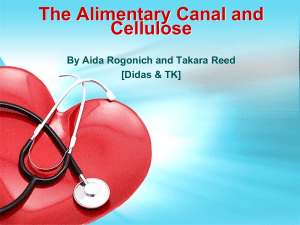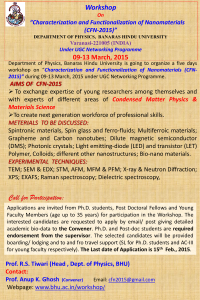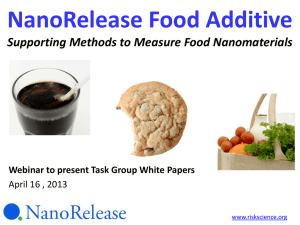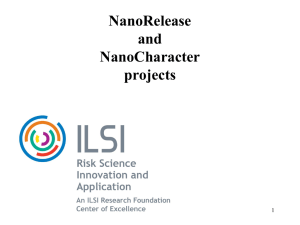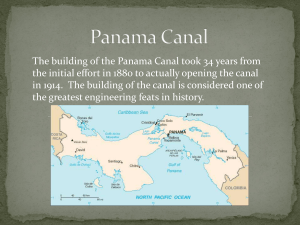(April 16 2013 Webinar - NanoRelease Food Additive) final
advertisement
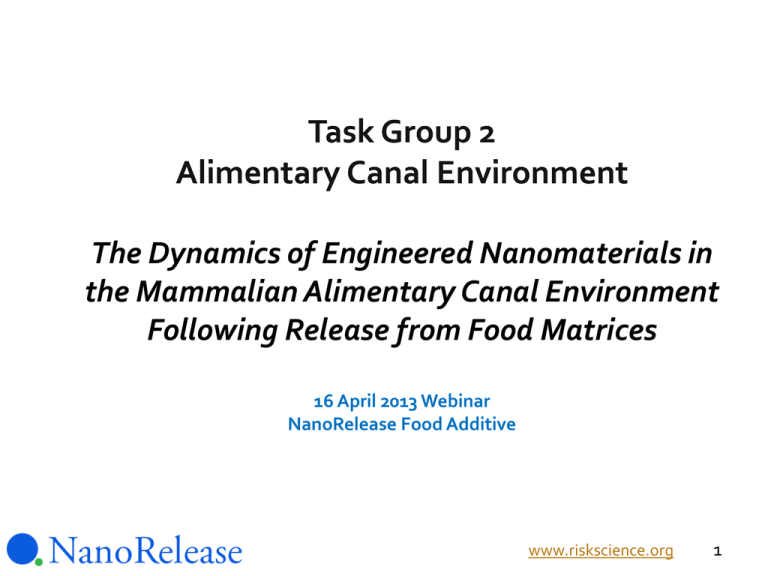
The Dynamics of Engineered Nanomaterials in the Mammalian Alimentary Canal Environment Following Release from Food Matrices 16 April 2013 Webinar NanoRelease Food Additive www.riskscience.org 1 Task Group 2 – Charges …the gastrointestinal tract is complex, composed of numerous cell types and environments… AIM Discussing the potential dynamics of nanoparticle interactions within the GI tract TG2 in the NanoRelease Food Additive Project TG2 white paper aim to inform and provide input to TG3 (Modelling) and TG4 (Measurement Methods) TG2 – Alimentary Canal Environment www.riskscience.org 2 Task Group 2 – Charges 1. Review physical, chemical, physiologic and anatomic context of the GI tract 2. Anatomy and physiology in relation to nanomaterial uptake likelihood (e.g. villi, Peyers patches, M-cells etc) 3. Physico-chemical factors of the gut that affect aggregation/agglomeration and dissolution transitions of nanoparticles (e.g. pH, redox, temperature, enzymes, surfactants, etc). 4. Lumen content and composition (e.g. insoluble fiber, bacteria, large particles, etc) that may influence nanoparticle characteristics and properties (opsonization, corona formation and dynamics) 5. Human variation in physiological state, age, disease, hormonal status, phenotypic variation… www.riskscience.org 3 TG2: Alimentary Canal Environment MEMBERS Susann Bellman (COCHAIR) TNO Netherlands David Carlander (COCHAIR) Nanotechnology Industries Association John Milner (advisor) Brian Lee Human Nutrition Research Ctr. (USDA) MassGen Hospital (Gastroenterology, Nutrition, Mucosal Immun.& Biology) GE Global Research Bruce Hamaker Purdue University David Lefebvre Health Canada Dora Pereira MRC Human Nutrition Research Dragan Momcilovic US Food and Drug Admin. James Waldman Ohio State University Joseph Scimeca Cargill, ILSI North America Jozef Kokini Univ. of Illinois Lourdes Gombau Leitat Tech. Center Alessio Fasano www.riskscience.org 4 Task Group 2 – White Paper Chapters 1. Introduction 2. Alimentary canal anatomy and mucosal cell types involved in the exclusion or absorption of nanomaterials 3. Gastrointestinal luminal factors affecting nanomaterials 4. Impact of physiological variability 5. Conclusions This presentation focuses on the main findings from the chapters above TG2 – Alimentary Canal Environment www.riskscience.org 5 Q: What can Chapter 1: Introduction be measured to understand ‘Setting the scene’ uptake • The human gut has been exposed to particles of varying sizes for likelihood? millennia, either exogenous from the diet (for example ferritin) or endogenously formed (for example calcium phosphates). • The properties of the atoms on the surface of nanomaterials affect their dynamics. The surface can bind reversibly or irreversibly bind molecules from their environment. The resulting corona also affects behaviour. • Size is an important characteristic • The physicochemical surface properties of the nanomaterials can affect release from the food matrix, solubility, stability, interactions with mucus, interactions with the apical cell membrane and absorption • The fraction of material which is not absorbed, or which has been secreted back into the lumen via enterohepatic circulation, is excreted in the faeces. Is there recirculation and toxicity in the enterohepatic pathway? TG2 – Alimentary Canal Environment www.riskscience.org 6 Q: What can Chapter 1: Introduction be measured to understand uptake • Nanomaterials can have complex dynamics during their transit likelihood? along the gastrointestinal tract due: • changing pH in the various segments (buccal cavity, stomach, gut, colon) • digestive enzymes (in the buccal cavity, stomach and gut) • bacteria (in the buccal cavity and colon). • Opsonization/corona formation • Reversible dynamics can occur e.g.: • reversible agglomeration(and/or aggregation?) during transit through the lumen • re-formation of nanomaterials in the lumen or in cells from ions. • It can be challenging to separate the detection of administered engineered nanomaterials from the natural nanomaterials present in food and living tissues. TG2 – Alimentary Canal Environment www.riskscience.org 7 Q: What can Chapter 2: Alimentary canal anatomy and mucosal cell be measured to understand types involved in the exclusion or absorption of uptake nanomaterials likelihood? • If a given class of nanomaterials quickly dissolves or digests following release from the food matrix, the buccal cavity may be the only tissue with limited exposure to the nanomaterial. • The dissolved material may be considered equivalent to the standard ionic form. • If a nanomaterial class forms permanent aggregates, the material could be studied in comparison with bulk materials. Test methods and models: Buccal/gastric dissolution models? TG2 – Alimentary Canal Environment www.riskscience.org 8 Q: What can Chapter 2: Alimentary canal anatomy and mucosal cell be measured to understand types involved in the exclusion or absorption of uptake nanomaterials likelihood? • If primary nanoparticles are stable and remain single particles, the small intestine would be an important segment to study with regard to absorption. • Absorptive enterocytes are important since they are the most abundant cell type. • • M cells in the Peyer’s patch epithelium make up less than 1 % of the alimentary canal surface area, but are the cell type most specialized for the uptake of particulate matter. Mucus secreted by Goblet cells coats the gut mucosa. Mucosa may be a barrier to the absorption of some nanomaterials or may enhanced absorption by mucoadhesive properties that increase residence time in the intestinal wall and consequently absorption Test methods and models: Intestinal wall models with enterocytes and goblet cells? TG2 – Alimentary Canal Environment www.riskscience.org 9 Chapter 3: Gastrointestinal luminal factors affecting nanomaterials Q: What can be measured to understand uptake likelihood? • In the upper gastrointestinal tract nanoparticles may aggregate (so that their behaviour during at least part of the exposure process is more typical of large particles even though their single unit is as a small particle) or dissolve (so that they then behave like their soluble constituents) and then lower down the GI tract those that aggregated may dissolve and vise-versa. • E.g. iron oxide particles that can become solubilized in the acidic environment of the stomach but then agglomerate together with other dietary constituents (such as low molecular weight ligands) forming nanoparticles when released into the near neutral environment of the small intestine. Test methods and models: De- and Agglomeration/Aggregation models in various GI environments? TG2 – Alimentary Canal Environment www.riskscience.org 10 Chapter 3: Gastrointestinal luminal factors affecting nanomaterials Q: What can be measured to understand uptake likelihood? • Nanoparticles are rarely seen by cells in their ‘native form’. Most nanoparticles readily adsorb to their surface molecules and ions from their environment. In the gut, particle surfaces may be ‘cleared’ in the acid and enzyme-active area of the stomach but readsorb material further down the GI tract. In this environment, bacterial proteins and carbohydrates are especially common. The formation of protein corona is a special consideration. • The way nanoparticles are presented to the gut-lining cells will depend on their mobility through mucus, on their interaction with bile salts and other luminal contents, pH gradients, presence of electrolytes and local ionic strength, fasted and fed state conditions. Test methods and models: ‘Standardised’ corona models in various GI environments? TG2 – Alimentary Canal Environment www.riskscience.org 11 Chapter 3: Gastrointestinal luminal factors affecting nanomaterials Q: What can be measured to understand uptake likelihood? • Even though M-cells are not one of the most abundant cell types in the GI tract they are very specialized for the uptake of particles and therefore provide a significant route of uptake of particles in the GI tract, and the only one significant for larger particles. • Transcellular vs paracellular pathways. Other routes include endocytosis through enterocytes or persorption through gaps in the tight junctions. Both of these mechanisms are more significant for smaller nanomaterials. • Little is known about the interactions between food related nano particles and the gut flora, adherence of gut bacteria to nano particles can result in biofilm formation and subsequent persistence of nano particles Test methods and models: M-cell models? Endocytosis/persorption models? TG2 – Alimentary Canal Environment www.riskscience.org 12 Chapter 4: Impact of physiological variability Q: What can be measured to understand uptake likelihood? • High doses of some unique classes of nanomaterials may have an impact on intestinal permeability, which could be a confounding effect in studies. • The alimentary canal of individuals with certain diseases can have a tendency for higher permeability to particulate matter. • The present white paper only briefly described natural physiological variability and disease states. • There is a data gap with regard to studies on the quantification of nanomaterials in the alimentary canal of individuals with states of altered physiology. Risk assessment sometimes uses inter-individual uncertainty factors to account for this. • Bioavailability (the proportion of material which is absorbed) is an important parameter to study in both the healthy and diseased state Test methods and models: Models with altered physiology? Bioavailibility models? TG2 – Alimentary Canal Environment www.riskscience.org 13 Chapter 5: White Paper Conclusions • While current food risk assessment guidelines, some of which include studies in animal models, capture and ensure the safety of nanomaterial products, there is currently a gap in the availability of validated alternative models for the study of nanomaterial dynamics such as bioavailabililty. TG2 – Alimentary Canal Environment www.riskscience.org 14 Additional considerations • Continue to address and discuss behaviour of the three categories of materials identified in TG1: • Category 1: Soft/lipid-based nanomaterials • Category 2: Solid non-lipid non-metal nanomaterials • Category 3: Solid metalloid/metal-based nanomaterials • Fate and behaviour (systemic toxicity) of NM after intestinal barrier translocation is outside scope of this NanoRelease Food Additive Project TG2 – Alimentary Canal Environment www.riskscience.org 15 On behalf of TG2 Thank you for your attention! TG2 – Alimentary Canal Environment www.riskscience.org 16
